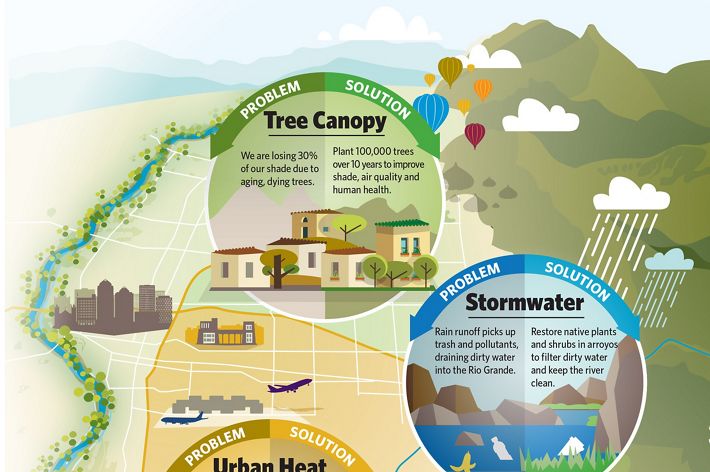Planting Trees in Albuquerque
We're working with local partners and communities to plant trees and enhance the relationship between cities and nature so both can thrive.
Albuquerque is a city set in nature. Imagine now if that natural linkage was deliberate and interwoven with the city’s social and economic fabric.
Today almost 600,000 people call the city home. According the U.S. Census Bureau, it’s the sixth fastest growing mid-size city in the country (2014).
WHAT’S THE PROBLEM?
As urban areas grow, there’s an increasing disconnect between people and surrounding natural areas. That’s why The Nature Conservancy is working to fundamentally change the relationship between cities and nature so that both can thrive.
In New Mexico, we’re going on our fourth year of our urban program in Albuquerque. “We want people to understand that sustainability of healthy cities is inextricably linked to a healthy environment,” says Sarah Hurteau, the Conservancy’s new Albuquerque Urban Program Director.
NATURE’S SOLUTIONS
Part of the Conservancy’s North America Urban Cities initiative, Albuquerque is one of more than 20 U.S. cities where we’re helping find natural solutions to improve quality of life and sustainability, especially for people in economically challenged neighborhoods. They face the greatest threats from degraded lands and waters—and stand to benefit the most from conserving and restoring these resources.
The program builds off the success of the Conservancy-developed Santa Fe Water Source Protection and Rio Grande Water Funds, both designed to increase water security in the face of a warming climate.
With a population approaching 600,000, Albuquerque offers opportunities to incorporate nature-based solutions. Examples could include managing storm-water runoff with natural areas, addressing “heat islands” by increasing urban tree canopy, and creating new wildlife corridors from the Rio Grande to the Sandia Mountains.
Another key component is engaging youth with opportunities to connect with nature in new ways.
THE PATH FORWARD
There’s a long road ahead. Right now, The Nature Conservancy is meeting the key players and cataloging existing programs and current thinking. TNC will assess conservation opportunities next. “We want this program to succeed well into the future, so we need to build trust and find middle ground,” says Sarah Hurteau, Albuquerque Urban Program Director. “When everyone has ownership, conservation projects are more sustainable.”
“It will take time, patience and perseverance but, for me, it’s all worth it,” Hurteau adds. “I’m excited to play a role in positively impacting the city I call home.”
Support Our Work in Urban Conservation
Donate to help create a more sustainable Albuquerque today and for future generations.

